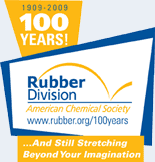![[ Visit ACS Rubber Website ]](images/logo.jpg) |
|
Centennial Elite SponsorsBecome a Centennial Elite Sponsor |
Characterization of the rubber-brass interfacial layerWednesday, October 14, 2009: 10:25 AM
325 (David L. Lawrence Convention Center )
Brass-plated steel tire cords form an essential strengthening component of a radial automobile tire. Adhesion between the rubber compound and the brass-plated steel tire cord has remarkable effect on the overall performance of tires. Rubber-brass interfacial adhesion depends on many factors such as chemical composition and thickness of the interfacial layer, which in turn are influenced by the rubber formulation. Previously, various adhesion promoters such as organic cobalt salts and resins have been used to impede degradation of the rubber-brass bonding layer during aging. It has been shown that the interfacial layer consists mainly of sulfides and oxides of copper and zinc. The present study aims at characterization of the rubber-brass interface to study aging effects on the morphological changes observed in the layer. Grazing incidence angle X-Ray Diffraction (GIXRD) experiments were done on polished brass coupons bonded to six experimental rubber compounds. The results obtained show that aging in heat and humidity lead to changes in the morphology and chemistry of the rubber-steel tire cord interface. Time-of-Flight Secondary Ion Mass Spectrometry (TOF-SIMS) surface analysis indicates the thickening of interfacial layer after aging and the effect of adhesion promoters on the nature of the interface. SEM/EDAX study also corroborates the findings from X-Ray Diffraction. The corrosion phenomenon happening as a result of heat and humidity aging has been studied using electrochemical techniques such as DC Polarization. Prolonged aging causes the sulfide layer to crystallize and makes the interface brittle causing it to fracture and eventually leading to failure between the sulfide layers and loss of adhesion at rubber-brass interface. These interfacial analyses will help in gaining a more profound understanding of the rubber-brass bonding mechanism.
|









